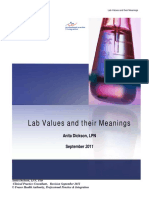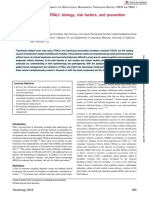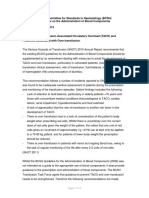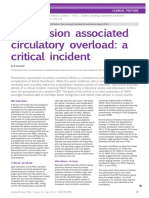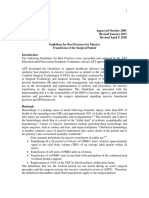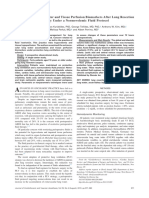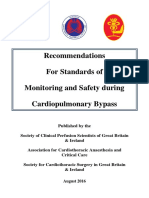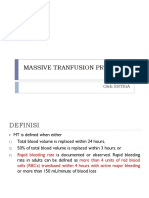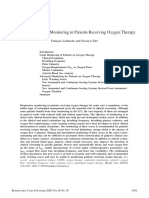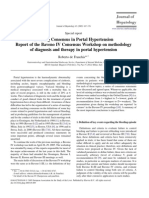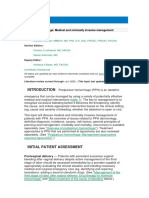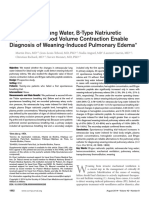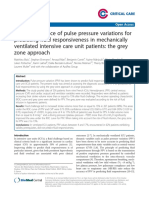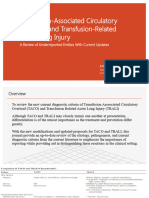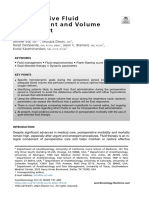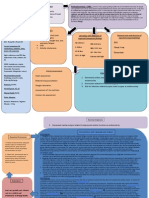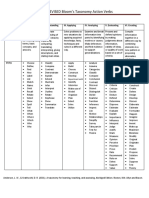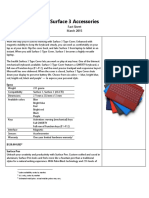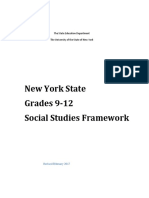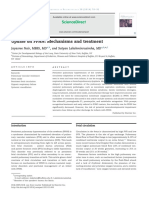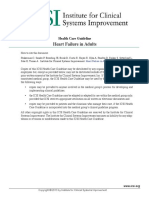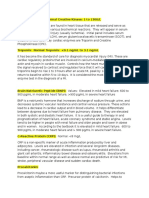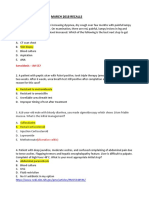Transfusion-Associated Circulatory Overload (TACO) Draft Revised Reporting Criteria
Transfusion-Associated Circulatory Overload (TACO) Draft Revised Reporting Criteria
Uploaded by
Aarón LinaresCopyright:
Available Formats
Transfusion-Associated Circulatory Overload (TACO) Draft Revised Reporting Criteria
Transfusion-Associated Circulatory Overload (TACO) Draft Revised Reporting Criteria
Uploaded by
Aarón LinaresOriginal Description:
Original Title
Copyright
Available Formats
Share this document
Did you find this document useful?
Is this content inappropriate?
Copyright:
Available Formats
Transfusion-Associated Circulatory Overload (TACO) Draft Revised Reporting Criteria
Transfusion-Associated Circulatory Overload (TACO) Draft Revised Reporting Criteria
Uploaded by
Aarón LinaresCopyright:
Available Formats
Transfusion-associated circulatory overload (TACO)
Draft revised reporting criteria
International Society of Blood Transfusion
Working Party on Haemovigilance
in collaboration with
The International Haemovigilance Network
These proposed surveillance reporting criteria represent a revision of the previous international
TACO definition published by the International Society for Blood Transfusion Haemovigilance working
party and International Haemovigilance Network:
http://www.isbtweb.org/fileadmin/user_upload/Proposed_definitions_2011_surveillance_non_infec
tious_adverse_reactions_haemovigilance_incl_TRALI_correction_2013.pdf
TACO definition revision group 1 April 2017
IHN/ISBT haemovigilance working party/AABB
Rationale for the revision
At the Amsterdam meeting of the ISBT haemovigilance working party (2013), a number of members
requested revision of the TACO definition. Notably, strict application of the definition leads to non-
acceptance of cases which would be accepted as TACO by clinicians and by some haemovigilance
systems.
A draft revised version was circulated in December 2014 and tested by contributors from
haemovigilance systems in several countries and continents by applying it to their own cases. This
definition was found to be more inclusive than the 2011 version but limited by the weight placed on
enlargement of the cardiac silhouette and increase of BNP – both are often not investigated or not
recorded in haemovigilance reports.
The revision group recognises that the chief priority is to adopt standard reporting criteria which will
enable professionals to raise awareness of TACO and lead to improved reporting, research and
reduction of transfusion complications. The revision group includes representatives from AABB, and
this opens possibilities for harmonisation. In future, the criteria may need to be adjusted in the light
of accumulating evidence.
The revision group (listed alphabetically)
Chester Andrzejewski, Paula Bolton-Maggs, Sharran Grey, Kevin Land, Harriet Lucero, Mark
Popovsky, Philippe Renaudier, Pierre Robillard, Matilde Santos, Martin Schipperus, Dafydd Thomas,
Barbee Whitaker, Johanna Wiersum-Osselton (convenor).
TACO definition revision group 2 April 2017
IHN/ISBT haemovigilance working party/AABB
Proposed standard reporting criteria (2017)
Transfusion-associated circulatory overload (TACO)
Context
The term transfusion-associated circulatory overload or TACO indicates that there is a
temporal association with blood transfusion. The imputability, the causal contribution of the
transfusion, is assessed separately.
Certain clinical conditions, e.g. cardiovascular, renal, pulmonary diseases and severe anemia,
are risk factors for TACO. These conditions do not preclude a diagnosis of TACO.
Other fluids given before or around the time of the transfusion contribute to and can
exacerbate the fluid challenges posed by transfusion. The volume of transfused products
may constitute only a percentage of fluids administered overall.
Patients with TACO cardinally manifest respiratory system-related signs and symptoms such
as tachypnea, dyspnea, and decreased oxygen saturations, typically occurring during or
within 12 hours of transfusion.
Close monitoring of the patient and the vital signs during transfusion are important; review
of vital sign values/net fluid balance for at least 24 hours prior to the transfusion of the unit
identified with the reaction may be of value.
An increase of blood pressure and tachycardia may be warning signs; appropriate clinical
management may prevent development of TACO.
Radiographic chest imaging of adequate quality at the time of the reaction is an important
means of gaining diagnostic information and should be considered. However, cases without
chest imaging may be reported as TACO providing other features are present.
Patients with TACO may experience an increase in body temperature. An increase of body
temperature should be investigated according to protocol and clinical judgement. Increased
body temperature does not exclude TACO if the reporting criteria are met.
Patients receiving ventilatory support: In ICU patients who may be receiving varying degrees
of PEEP (positive end expiratory pressure) ventilatory support, pulmonary oedema may be
difficult to diagnose at higher PEEP settings with TACO becoming apparent only if PEEP
settings are reduced or ventilation is discontinued.
TACO reporting criteria*
Patients classified with a TACO (surveillance diagnosis) should have acute or worsening respiratory
compromise during or up to 12 hours after transfusion and should exhibit two or more of the criteria
below:
Evidence of acute or worsening pulmonary oedema based on:
o clinical physical examination (see Note 1), and/or
o radiographic chest imaging and/or other non-invasive assessment of cardiac function e.g.
echocardiogram (see Note 2)
TACO definition revision group 3 April 2017
IHN/ISBT haemovigilance working party/AABB
Evidence for cardiovascular system changes not explained by the patient’s underlying medical
condition, including development of tachycardia, hypertension, jugular venous distension,
enlarged cardiac silhouette and/or peripheral oedema (see Note 3)
Evidence of fluid overload including any of the following: a positive fluid balance; response to
diuretic therapy combined with clinical improvement; and change in the patient’s weight in the
peri-transfusion period (see Note 4)
Elevation in B type natriuretic peptide (NP) levels (e.g., BNP or NT-pro BNP) to greater than 1.5
times the pretransfusion value. A normal post-transfusion NP level is not consistent with a
diagnosis of TACO; serial testing of NP levels in the peri-transfusion period may be helpful in
identifying TACO.
*These criteria establish a surveillance definition based on a complete description of an event,
including information that becomes available well after onset. This is for reporting and tracking
purposes and the criteria do not constitute clinical diagnosis for the purpose of real-time clinical
interventions.
Notes
1. Clinical findings could include crackles on lung auscultation, orthopnea and cough, cyanosis
and decreased oxygen saturation values in the absence of other specific causes.
2. Diagnostic radiographic imaging
Findings consistent with pulmonary oedema from circulatory overload could include presence of new
or worsening pleural effusions, progressive lobar vessel enlargement, peribronchial cuffing, bilateral
Kerley lines, alveolar oedema with nodular areas of increased opacity and/or cardiac silhouette
enlargement.
3. Blood pressure monitoring
Often the arterial pressure is raised, often with widened pulse pressure; however hypotension may
be a presenting feature, e.g. in patients in a state of acute cardiac collapse.
Blood pressure should be monitored especially if multi-unit transfusions are given.
4. Change in the patient’s weight
Typically the patient’s weight will increase. However there may be a decrease following diuretic
therapy.
Imputability
The imputability, the causal contribution of the transfusion, is assessed separately.
TACO definition revision group 4 April 2017
IHN/ISBT haemovigilance working party/AABB
You might also like
- Bundle Three Hour SSC PDFDocument14 pagesBundle Three Hour SSC PDFRodrigo RochaNo ratings yet
- Novel Tools For Hemodynamic Monitoring in Critically Ill Patients With Shock - UpToDateDocument26 pagesNovel Tools For Hemodynamic Monitoring in Critically Ill Patients With Shock - UpToDateAlex KuliaNo ratings yet
- Prana RupaDocument34 pagesPrana RupaZoltan VasaNo ratings yet
- Part 1 SAQs Specimen QuestionsDocument79 pagesPart 1 SAQs Specimen Questionsخولة رشيد العيسى100% (2)
- 004 LabsDiagnosticsManualDocument64 pages004 LabsDiagnosticsManualRaju Niraula100% (1)
- Chan, Johnson - TreatmentGuidelines PDFDocument0 pagesChan, Johnson - TreatmentGuidelines PDFBogdan CarabasNo ratings yet
- TAPVC Repair MedcoDocument4 pagesTAPVC Repair MedcoChandan SinghNo ratings yet
- Taco Trali Ash 2018Document10 pagesTaco Trali Ash 2018Grisel MezaNo ratings yet
- Blood Admin Addendum 2012Document4 pagesBlood Admin Addendum 2012Sanjeewa WijayawickramaNo ratings yet
- Transfusion Associated Circulatory Overload Taco Emma GoodhallDocument5 pagesTransfusion Associated Circulatory Overload Taco Emma GoodhallAthirah M.NoerNo ratings yet
- Less Invasive Hemodynamic Monitoring in Critically Ill PatientsDocument11 pagesLess Invasive Hemodynamic Monitoring in Critically Ill Patientsهبة بسمان شاكرNo ratings yet
- jurnal transliteDocument18 pagesjurnal transliteShin ChanNo ratings yet
- Taco TraliDocument10 pagesTaco TralimanuelNo ratings yet
- 3.guideline Massive TransfusionDocument17 pages3.guideline Massive Transfusionsadam sodomNo ratings yet
- 1-s2.0-S1053077014006569-main (1)Document7 pages1-s2.0-S1053077014006569-main (1)skimtbgameNo ratings yet
- Noninvasive Monitoring 2016Document6 pagesNoninvasive Monitoring 2016Maria LaiaNo ratings yet
- Contemporary Perioperative Haemodynamic MonitoringDocument12 pagesContemporary Perioperative Haemodynamic MonitoringrjerezrNo ratings yet
- Ab15 02Document14 pagesAb15 02KirandragonNo ratings yet
- Recommendations For Standards of Monitoring and Safety During Cardiopulmonary BypassDocument16 pagesRecommendations For Standards of Monitoring and Safety During Cardiopulmonary BypassThulasi MuniappanNo ratings yet
- Clinical Review: Hemodynamic Monitoring in The Intensive Care UnitDocument8 pagesClinical Review: Hemodynamic Monitoring in The Intensive Care Unitmasfak97No ratings yet
- Association Between Fluid Overload and SOFA Score Kinetics in Septic Shock Patients: A Retrospective Multicenter StudyDocument18 pagesAssociation Between Fluid Overload and SOFA Score Kinetics in Septic Shock Patients: A Retrospective Multicenter StudydaliaNo ratings yet
- Massive Tranfusion Protocol: Oleh ErtigaDocument13 pagesMassive Tranfusion Protocol: Oleh ErtigaAnonymous BQM9271ZXNo ratings yet
- SUBJECT: Pre-Op Workup Q: A:: Australian Consortium For Classification DevelopmentDocument24 pagesSUBJECT: Pre-Op Workup Q: A:: Australian Consortium For Classification DevelopmentNur Ighwana SariNo ratings yet
- OxigenoterapiaDocument10 pagesOxigenoterapiaGabriel AlvesNo ratings yet
- Baveno IVDocument10 pagesBaveno IVdepe_cutzNo ratings yet
- Hemodynamic Parameters To Guide Fluid Therapy: Review Open AccessDocument9 pagesHemodynamic Parameters To Guide Fluid Therapy: Review Open AccessClaudioValdiviaNo ratings yet
- Management of The Difficult-To-Wean Adult Patient in The Intensive Care Unit - UpToDateDocument19 pagesManagement of The Difficult-To-Wean Adult Patient in The Intensive Care Unit - UpToDateJulio AceroNo ratings yet
- HD Moniroriz Reviw 2023Document17 pagesHD Moniroriz Reviw 2023DanaNo ratings yet
- VMNIDocument11 pagesVMNINeumología UMAE 34No ratings yet
- 1 s2.0 S1053077019303039 MainDocument6 pages1 s2.0 S1053077019303039 MainADELIAADENo ratings yet
- Bedside Hemodynamic MonitoringDocument26 pagesBedside Hemodynamic MonitoringBrad F LeeNo ratings yet
- J of Clinical Hypertension - 2021 - Weber - Hypertension in Asia 2021 A Major Contribution To WorldwidDocument3 pagesJ of Clinical Hypertension - 2021 - Weber - Hypertension in Asia 2021 A Major Contribution To Worldwiddickyfebrian28888No ratings yet
- Cytologic and Hematologic Tests Arterial Blood Gases: Medical Background: Chronic Restrictive Pulmonary DiseaseDocument7 pagesCytologic and Hematologic Tests Arterial Blood Gases: Medical Background: Chronic Restrictive Pulmonary Diseasejoanna gurtizaNo ratings yet
- I Hi Severe Sepsis BundlesDocument59 pagesI Hi Severe Sepsis BundlesPedro AliagaNo ratings yet
- IpDocument7 pagesIpMohd Ashaf Amat KhainanNo ratings yet
- Authors: Section Editors: Deputy EditorDocument20 pagesAuthors: Section Editors: Deputy EditorSajal SahaNo ratings yet
- Management of Abdominal Compartment Syndrome and The Open AbdomenDocument9 pagesManagement of Abdominal Compartment Syndrome and The Open AbdomennucaiceNo ratings yet
- Haemodynamic MonitoringDocument6 pagesHaemodynamic MonitoringAnusha Verghese100% (1)
- Postpartum Hemorrhage: Medical and Minimally Invasive ManagementDocument33 pagesPostpartum Hemorrhage: Medical and Minimally Invasive ManagementMayrita NamayNo ratings yet
- Circulation 2015 AlternatifDocument9 pagesCirculation 2015 AlternatifnunungNo ratings yet
- Los Cambios Dinámicos de Las Velocidades Doppler de La Vena HepáticaDocument9 pagesLos Cambios Dinámicos de Las Velocidades Doppler de La Vena HepáticaDarwin CamposNo ratings yet
- Clinical Presentation and Diagnostic Evaluation of Ventilator-Associated Pneumonia - UpToDateDocument27 pagesClinical Presentation and Diagnostic Evaluation of Ventilator-Associated Pneumonia - UpToDateLUCIANA MILAGROS ZAPATA BENITESNo ratings yet
- EVLW BNP and Blood Contraction in Weaning-Induced Pulmonary Edema - Crit Care Med 2014Document8 pagesEVLW BNP and Blood Contraction in Weaning-Induced Pulmonary Edema - Crit Care Med 2014oscarpalaciosNo ratings yet
- Indicator PVR ManuscriptDocument20 pagesIndicator PVR ManuscriptshanizaNo ratings yet
- CHF I and o Paper-2Document13 pagesCHF I and o Paper-2api-665163291No ratings yet
- Postpartum Hemorrhage - Medical and Minimally Invasive Management - Uptodate FreeDocument59 pagesPostpartum Hemorrhage - Medical and Minimally Invasive Management - Uptodate FreecarolinaNo ratings yet
- s13054 014 0587 9 PDFDocument11 pagess13054 014 0587 9 PDFelias veraNo ratings yet
- Noninvasive Hemodynamic Monitoring in The Intensive Care UnitDocument18 pagesNoninvasive Hemodynamic Monitoring in The Intensive Care UnitmegaNo ratings yet
- HemodynamicDocument8 pagesHemodynamicaderohmanaspanNo ratings yet
- Hemodynamic Assessment in The Contemporary ICUDocument33 pagesHemodynamic Assessment in The Contemporary ICUnacxit6No ratings yet
- Transfusion-Associated Circulatory Overload and Transfusion-Related Acute Lung InjuryDocument14 pagesTransfusion-Associated Circulatory Overload and Transfusion-Related Acute Lung InjuryGloria ThomasNo ratings yet
- Clinical Presentation and Diagnostic Evaluation of Ventilator-Associated PneumoniaDocument33 pagesClinical Presentation and Diagnostic Evaluation of Ventilator-Associated Pneumoniamayteveronica1000No ratings yet
- Taco VS Trali - Back Up SlideDocument9 pagesTaco VS Trali - Back Up SlideRizma RachmiNo ratings yet
- Transfusion Reactions With Respiratory Symptoms: TRALI / TACO / TADDocument36 pagesTransfusion Reactions With Respiratory Symptoms: TRALI / TACO / TADIrma Vallejos ArteagaNo ratings yet
- Elia Jennifer Perioperative Fluid Management andDocument19 pagesElia Jennifer Perioperative Fluid Management andSiddhartha PalaciosNo ratings yet
- CC-Concept Map 2Document5 pagesCC-Concept Map 2MDCITY50% (2)
- A Protocol For Resuscitation of Severe Burn Patients Guided by Transpulmonary Thermodilution and Lactate LevelsDocument8 pagesA Protocol For Resuscitation of Severe Burn Patients Guided by Transpulmonary Thermodilution and Lactate LevelsMaria de los Angeles ZamoranoNo ratings yet
- Executive Summary: Supplement ArticleDocument65 pagesExecutive Summary: Supplement ArticleLeo F ForeroNo ratings yet
- Audit Criteria TransfusionDocument6 pagesAudit Criteria TransfusionDaniel ChristoNo ratings yet
- Capillary Refill Time Variation Induced by Passive Leg Raising Predicts Capillary Refill Time Response To Volume ExpansionDocument11 pagesCapillary Refill Time Variation Induced by Passive Leg Raising Predicts Capillary Refill Time Response To Volume ExpansionLarissa BianchiniNo ratings yet
- Blood Transfusion AssignmentDocument6 pagesBlood Transfusion Assignmentlish9990No ratings yet
- Pals 2015Document18 pagesPals 2015Sardono WidinugrohoNo ratings yet
- Hemovigilance: An Effective Tool for Improving Transfusion SafetyFrom EverandHemovigilance: An Effective Tool for Improving Transfusion SafetyRené R. P. De VriesNo ratings yet
- Revised Blooms Taxonomy Action VerbsDocument1 pageRevised Blooms Taxonomy Action VerbsAarón LinaresNo ratings yet
- List of Irregular Verbs 1Document3 pagesList of Irregular Verbs 1Jaya BabuNo ratings yet
- List of Irregular Verbs 1Document3 pagesList of Irregular Verbs 1Jaya BabuNo ratings yet
- 6 Grade Science Scope and SequenceDocument7 pages6 Grade Science Scope and SequenceAarón LinaresNo ratings yet
- Surface 3 Accessories FsDocument4 pagesSurface 3 Accessories FsAarón LinaresNo ratings yet
- Halloween Window Decorating Contest: 2017 Theme: Monster MashDocument1 pageHalloween Window Decorating Contest: 2017 Theme: Monster MashAarón LinaresNo ratings yet
- Chicken Tacos: IngredientsDocument1 pageChicken Tacos: IngredientsAarón LinaresNo ratings yet
- Summary Paper Due DiligenceDocument8 pagesSummary Paper Due DiligenceAarón LinaresNo ratings yet
- NSW Spectacles Program - Information Sheet: Who Is Eligible For This Program?Document2 pagesNSW Spectacles Program - Information Sheet: Who Is Eligible For This Program?Aarón LinaresNo ratings yet
- Dilated Eye ExamDocument4 pagesDilated Eye ExamAarón LinaresNo ratings yet
- History Study Summary 2016Document8 pagesHistory Study Summary 2016Aarón LinaresNo ratings yet
- MS TR 99 30 Sloan Digital Sky SurveyDocument16 pagesMS TR 99 30 Sloan Digital Sky SurveyAarón LinaresNo ratings yet
- Get Up & Grow Healthy Eating and Physical Activity For Early ChildhoodDocument3 pagesGet Up & Grow Healthy Eating and Physical Activity For Early ChildhoodAarón LinaresNo ratings yet
- New York State Grades 9-12 Social Studies FrameworkDocument51 pagesNew York State Grades 9-12 Social Studies FrameworkAarón LinaresNo ratings yet
- 2017 - Guideline Hearth Failure PDFDocument129 pages2017 - Guideline Hearth Failure PDFMarvin M. Vargas AlayoNo ratings yet
- Point of Care Cardiac MarkersDocument14 pagesPoint of Care Cardiac MarkersLien TranNo ratings yet
- LP AdhfDocument20 pagesLP AdhfsudiNo ratings yet
- 10-Primary Care - AAFP Flashcards - Quizlet PDFDocument870 pages10-Primary Care - AAFP Flashcards - Quizlet PDFehabb350% (2)
- Copd and Cardiovascular Disease: Original ArticleDocument9 pagesCopd and Cardiovascular Disease: Original Articlemgoez077No ratings yet
- Copd and Cor PulmonalDocument14 pagesCopd and Cor PulmonalAldi RafaelNo ratings yet
- Medico Graph I A 123Document124 pagesMedico Graph I A 123Rafael CastilloNo ratings yet
- Update On PPHN: Mechanisms and Treatment: Jayasree Nair, MBBS, MD, and Satyan Lakshminrusimha, MDDocument14 pagesUpdate On PPHN: Mechanisms and Treatment: Jayasree Nair, MBBS, MD, and Satyan Lakshminrusimha, MDhasan bukhoriNo ratings yet
- Cardiac Enzymes - KulDocument39 pagesCardiac Enzymes - KulAnonymous J1iWk2xNo ratings yet
- Clinical ChemistryDocument12 pagesClinical ChemistryClark Lopez100% (1)
- Heart FailureDocument94 pagesHeart FailureAnusha Verghese100% (1)
- Attending COPD Exacerbation ModuleDocument9 pagesAttending COPD Exacerbation ModuleJonathan AiresNo ratings yet
- Cardiac Biomarker 2014Document52 pagesCardiac Biomarker 2014karin amalia sabrina100% (1)
- Constrictive Pericarditis - UpToDateDocument26 pagesConstrictive Pericarditis - UpToDateSebastian CastañedaNo ratings yet
- Heart Failure in ChildrenDocument9 pagesHeart Failure in ChildrenGustiTiballaNo ratings yet
- Cardiac Biomarkers PDFDocument5 pagesCardiac Biomarkers PDFSaraswati Wulandari HartonoNo ratings yet
- Primary Care - AAFP Flashcards - Quizlet PDFDocument879 pagesPrimary Care - AAFP Flashcards - Quizlet PDFAkash Bhatnagar100% (4)
- HeartFailure PDFDocument95 pagesHeartFailure PDFOktavianus PrayitnoNo ratings yet
- 10) Dyspnea Nov 2016 PDFDocument99 pages10) Dyspnea Nov 2016 PDFGopala HariNo ratings yet
- Transfusion-Associated Circulatory Overload (TACO) Draft Revised Reporting CriteriaDocument4 pagesTransfusion-Associated Circulatory Overload (TACO) Draft Revised Reporting CriteriaAarón LinaresNo ratings yet
- CV DR Aysha Habib KhanDocument18 pagesCV DR Aysha Habib KhanJumadil MakmurNo ratings yet
- Cardiac EnzymesDocument4 pagesCardiac EnzymesviaereaNo ratings yet
- 2019 Nclex RN Cram SheetDocument7 pages2019 Nclex RN Cram Sheetpjhay93% (82)
- Noninvasive Mechanical Ventilation and Difficult Weaning in Critical CareDocument442 pagesNoninvasive Mechanical Ventilation and Difficult Weaning in Critical CareCritical Group100% (10)
- Constrictive and Restrictive Cardiomyopathy PDFDocument19 pagesConstrictive and Restrictive Cardiomyopathy PDFdawnkuruvillaNo ratings yet
- Medical Revision PaperDocument106 pagesMedical Revision PaperDavin SugumarNo ratings yet




